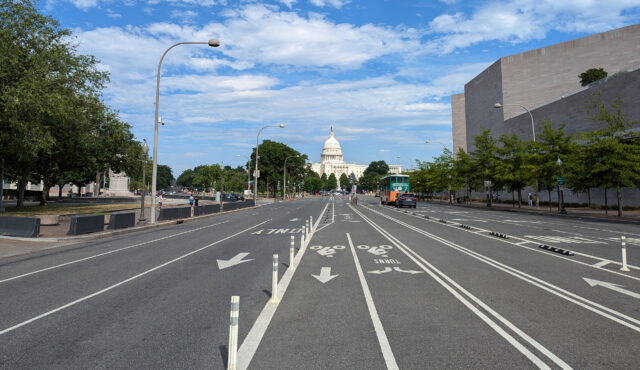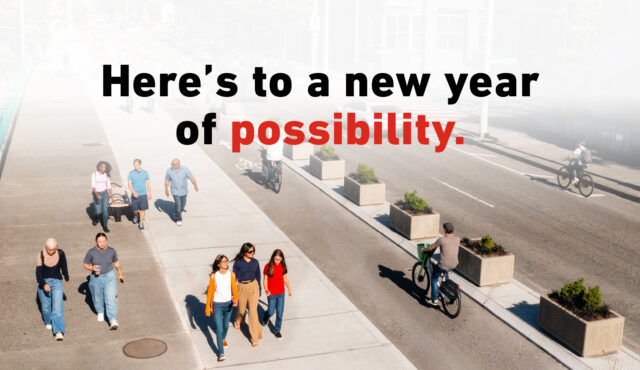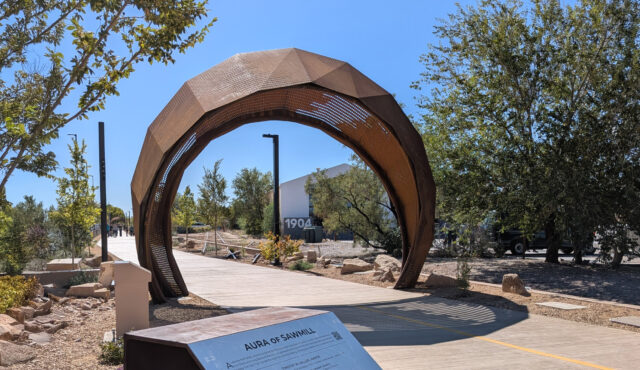What’s In the Infrastructure Investment and Jobs Act?
Active transportation projects and programs received a major boost with passage of the Infrastructure Investment and Jobs Act of 2021 on November 5th. The legislation reauthorizes existing Federal transportation programs and establishes several new ones. Overall, surface transportation programs receive a significant increase in funding (for example Federal funding for highways increases from $49 billion in 2021 to an average of more than $70 billion a year; transit goes from $12.8 billion to $18.2 billion a year). There are equally significant increases and changes to active transportation programs.
Most notably, for example, there is a 60% increase in funding for the Transportation Alternatives Program (technically, the Surface Transportation Block Grant Program Set-aside). There is also a major focus on traffic safety that could have a profoundly beneficial impact on vulnerable road users.
Here’s a quick summary of some of the main provisions related to active transportation:
New Programs
- $1 billion a year for a new Safe Streets and Roads for All grant program to support local initiatives to prevent death and serious injury on roads and streets, including comprehensive road safety plans
- $100 million a year for a new Healthy Streets grant program to “deploy cool pavements and porous pavements” and “expand tree cover” to mitigate urban heat islands, improve air quality, and reduce stormwater runoff
- $2 billion over five years for a new, competitive rural surface transportation program
- $1 billion over five years for a new Reconnecting Communities competitive grant program, $200 million for planning and $800 million for construction, to remove, retrofit, or mitigate highways that have divided communities and created barriers to opportunity.
These are competitive grant programs to be established and administered by the US Department of Transportation. Each will have its own process, criteria, eligibility, call for applications, etc. to follow.
New Requirements in Existing Programs
- States with high ped/bike fatality numbers (15% of more of their total) will be required to spend at least 15% of their Highway Safety Improvement Program funds on ped/bike safety projects
- All states must complete a Vulnerable Road User Safety Assessment within the next two years
- States and MPOs must use at least 2.5% of their Federal planning funds to adopt or develop Complete Streets standards/guidance/policies; develop a complete streets prioritization plan; or develop an active transportation plan [of some kind]
- There is $750 million over five years to “revise the crash data collection system” in part so crash reports distinguish electric scooters and bicycles from other vehicles.
Changes to Existing Programs
- Funding for the Transportation Alternatives Program (TAP) increases by about 60%; it goes from a flat $850 million reservation from the Surface Transportation Block Grant Program to a 10% set-aside from that program which comes to an average of $1.44 billion a year. TAP funds bicycle and pedestrian projects, safe routes to school, recreational trails, etc.
- A broad range of traffic calming and speed reduction measures are explicitly added to the list of eligible activities under the Highway Safety Improvement Program
- The Safe Routes to School program is codified (in a new Section 208) and expanded to explicitly include High Schools and non-infrastructure activities; although funding is still optional
- The MUTCD is to explicitly “promote the safety, inclusion, and mobility of all users” and has to be updated within 18 months and then at least every 4 years after that
- “Shared micromobility” is added to the definition of pedestrian and bicyclist projects in the key Section 213; and “shared micromobility (including bikesharing and shared scooter systems)” is explicitly made eligible for CMAQ funding.
These changes may require program guidance from the relevant administering agency within USDOT.
Administrative Changes to Programs
- States may use up to 5% of TAP funding for staffing and technical assistance
- Individual projects can be 100% federally funded provided each program overall meets the appropriate share of Federal funding (usually 80/20)
- States have to get FHWA certification to transfer funds between certain programs
- More local control is granted over TAP and Surface Transportation Block Grant programs
- All NHTSA sections of the law to refer to “crashes” and not “accidents”
- Metropolitan planning can explicitly link to housing issues
- Emergency Relief projects can include complete streets solutions
These changes may require program guidance from the relevant administering agency within USDOT.
Additional Items
The legislation is 1,039 pages long and has extensive sections on transit, rail, motor carrier safety, research, safety, and more. There are also lengthy titles related to infrastructure for energy transmission, broadband, ports, drinking water etc. Some of the other high-profile transportation-related programs created by the legislation include:
- $27.5 billion for a Bridge formula program and a $12.5 billion Bridge Investment Program via a competitive grant program
- $7.5 billion for a National Electric Vehicle Formula Program
- $6.4 billion over five years for a carbon reduction program for a wide range of projects including active transportation and transit
- $50 million each year for a Congestion relief grant program for urbanized areas with 1 million or more population; for innovative, integrated, and multimodal solutions to congestion relief
- $8.7 billion over five years for the PROTECT (Promoting Resilient Operations for Transformative, Efficient, and Cost-saving Transportation) program to provide grants for “resilience improvements” including planning and construction grants
New programs like these will require guidance from the relevant agency within USDOT.
Disclaimer
This is an initial assessment of a very complex piece of legislation. There are a lot more details to come, and there are a lot of other programs, reports, changes to program eligibility, etc. that are not included here. Check out updates via our Insight posts at www.tooledesign.com, follow us on social media, and sign up for our newsletter, if you don’t already receive it.


